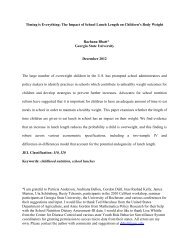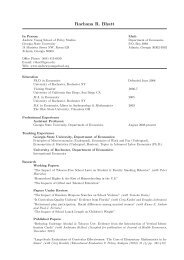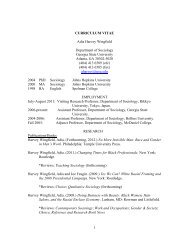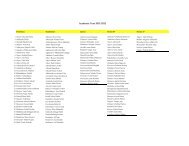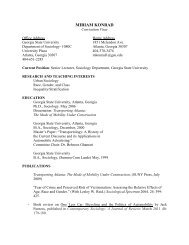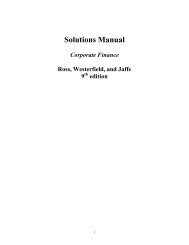CHAPTER 14: BOND PRICES AND YIELDS... to maturity
CHAPTER 14: BOND PRICES AND YIELDS... to maturity
CHAPTER 14: BOND PRICES AND YIELDS... to maturity
Create successful ePaper yourself
Turn your PDF publications into a flip-book with our unique Google optimized e-Paper software.
Chapter <strong>14</strong> - Bond Prices and Yields<br />
PROBLEM SETS<br />
<strong>CHAPTER</strong> <strong>14</strong>: <strong>BOND</strong> <strong>PRICES</strong> <strong>AND</strong> <strong>YIELDS</strong><br />
1. The bond callable at 105 should sell at a lower price because the call provision is more<br />
valuable <strong>to</strong> the firm. Therefore, its yield <strong>to</strong> <strong>maturity</strong> should be higher.<br />
2. Zero coupon bonds provide no coupons <strong>to</strong> be reinvested. Therefore, the inves<strong>to</strong>r's proceeds<br />
from the bond are independent of the rate at which coupons could be reinvested (if they<br />
were paid). There is no reinvestment rate uncertainty with zeros.<br />
3. A bond’s coupon interest payments and principal repayment are not affected by changes<br />
in market rates. Consequently, if market rates increase, bond inves<strong>to</strong>rs in the secondary<br />
markets are not willing <strong>to</strong> pay as much for a claim on a given bond’s fixed interest and<br />
principal payments as they would if market rates were lower. This relationship is<br />
apparent from the inverse relationship between interest rates and present value. An<br />
increase in the discount rate (i.e., the market rate) decreases the present value of the<br />
future cash flows.<br />
4. a. Effective annual rate for 3-month T-bill:<br />
4<br />
⎛100,<br />
000 ⎞<br />
4<br />
⎜ ⎟ −1<br />
= 1.<br />
02412 −1<br />
= 0.<br />
100<br />
⎝ 97,<br />
645 ⎠<br />
<strong>14</strong>-1<br />
= 10.<br />
0%<br />
b. Effective annual interest rate for coupon bond paying 5% semiannually:<br />
(1.05) 2 – 1 = 0.1025 or 10.25%<br />
Therefore the coupon bond has the higher effective annual interest rate.<br />
5. The effective annual yield on the semiannual coupon bonds is 8.16%. If the annual<br />
coupon bonds are <strong>to</strong> sell at par they must offer the same yield, which requires an annual<br />
coupon rate of 8.16%.<br />
6. The bond price will be lower. As time passes, the bond price, which is now above par<br />
value, will approach par.
Chapter <strong>14</strong> - Bond Prices and Yields<br />
7. Yield <strong>to</strong> <strong>maturity</strong>: Using a financial calcula<strong>to</strong>r, enter the following:<br />
n = 3; PV = −953.10; FV = 1000; PMT = 80; COMP i<br />
This results in: YTM = 9.88%<br />
Realized compound yield: First, find the future value (FV) of reinvested coupons and<br />
principal:<br />
FV = ($80 × 1.10 × 1.12) + ($80 × 1.12) + $1,080 = $1,268.16<br />
Then find the rate (yrealized ) that makes the FV of the purchase price equal <strong>to</strong> $1,268.16:<br />
$953.10 × (1 + yrealized ) 3 = $1,268.16 ⇒ yrealized = 9.99% or approximately 10%<br />
8. a. Zero coupon 8% coupon 10% coupon<br />
Current prices $463.19 $1,000.00 $1,134.20<br />
b. Price 1 year from now $500.25 $1,000.00 $1,124.94<br />
Price increase $37.06 $0.00 − $9.26<br />
Coupon income $0.00 $80.00 $100.00<br />
Pre-tax income $37.06 $80.00 $90.74<br />
Pre-tax rate of return 8.00% 8.00% 8.00%<br />
Taxes* $11.12 $24.00 $28.15<br />
After-tax income $25.94 $56.00 $62.59<br />
After-tax rate of return 5.60% 5.60% 5.52%<br />
c. Price 1 year from now $543.93 $1,065.15 $1,195.46<br />
Price increase $80.74 $65.15 $61.26<br />
Coupon income $0.00 $80.00 $100.00<br />
Pre-tax income $80.74 $<strong>14</strong>5.15 $161.26<br />
Pre-tax rate of return 17.43% <strong>14</strong>.52% <strong>14</strong>.22%<br />
Taxes** $19.86 $37.03 $42.25<br />
After-tax income $60.88 $108.12 $119.01<br />
After-tax rate of return 13.<strong>14</strong>% 10.81% 10.49%<br />
* In computing taxes, we assume that the 10% coupon bond was issued at par and<br />
that the decrease in price when the bond is sold at year end is treated as a capital<br />
loss and therefore is not treated as an offset <strong>to</strong> ordinary income.<br />
** In computing taxes for the zero coupon bond, $37.06 is taxed as ordinary<br />
income (see part (b)) and the remainder of the price increase is taxed as a capital<br />
gain.<br />
9. a. On a financial calcula<strong>to</strong>r, enter the following:<br />
n = 40; FV = 1000; PV = –950; PMT = 40<br />
You will find that the yield <strong>to</strong> <strong>maturity</strong> on a semi-annual basis is 4.26%. This<br />
implies a bond equivalent yield <strong>to</strong> <strong>maturity</strong> equal <strong>to</strong>: 4.26% × 2 = 8.52%<br />
Effective annual yield <strong>to</strong> <strong>maturity</strong> = (1.0426) 2 – 1 = 0.0870 = 8.70%<br />
<strong>14</strong>-2
Chapter <strong>14</strong> - Bond Prices and Yields<br />
b. Since the bond is selling at par, the yield <strong>to</strong> <strong>maturity</strong> on a semi-annual basis is the<br />
same as the semi-annual coupon rate, i.e., 4%. The bond equivalent yield <strong>to</strong><br />
<strong>maturity</strong> is 8%.<br />
Effective annual yield <strong>to</strong> <strong>maturity</strong> = (1.04) 2 – 1 = 0.0816 = 8.16%<br />
c. Keeping other inputs unchanged but setting PV = –1050, we find a bond<br />
equivalent yield <strong>to</strong> <strong>maturity</strong> of 7.52%, or 3.76% on a semi-annual basis.<br />
Effective annual yield <strong>to</strong> <strong>maturity</strong> = (1.0376) 2 – 1 = 0.0766 = 7.66%<br />
10. Since the bond payments are now made annually instead of semi-annually, the bond<br />
equivalent yield <strong>to</strong> <strong>maturity</strong> is the same as the effective annual yield <strong>to</strong> <strong>maturity</strong>. Using<br />
a financial calcula<strong>to</strong>r, enter: n = 20; FV = 1000; PV = –price, PMT = 80.<br />
The resulting yields for the three bonds are:<br />
Bond equivalent yield =<br />
Bond Price<br />
Effective annual yield<br />
$950 8.53%<br />
$1,000 8.00%<br />
$1,050 7.51%<br />
The yields computed in this case are lower than the yields calculated with semi-annual<br />
payments. All else equal, bonds with annual payments are less attractive <strong>to</strong> inves<strong>to</strong>rs<br />
because more time elapses before payments are received. If the bond price is the same<br />
with annual payments, then the bond's yield <strong>to</strong> <strong>maturity</strong> is lower.<br />
11.<br />
Price<br />
Maturity<br />
(years)<br />
Bond equivalent<br />
YTM<br />
$400.00 20.00 4.688%<br />
$500.00 20.00 3.526%<br />
$500.00 10.00 7.177%<br />
$385.54 10.00 10.000%<br />
$463.19 10.00 8.000%<br />
$400.00 11.91 8.000%<br />
12. a. The bond pays $50 every 6 months. The current price is:<br />
[$50 × Annuity fac<strong>to</strong>r (4%, 6)] + [$1,000 × PV fac<strong>to</strong>r (4%, 6)] = $1,052.42<br />
Assuming the market interest rate remains 4% per half year, price six months from<br />
now is:<br />
[$50 × Annuity fac<strong>to</strong>r (4%, 5)] + [$1,000 × PV fac<strong>to</strong>r (4%, 5)] = $1,044.52<br />
$ 50 + ($ 1,<br />
044.<br />
52 − $ 1,<br />
052.<br />
42)<br />
$ 50 − $ 7.<br />
90<br />
b. Rate of return =<br />
=<br />
$ 1,<br />
052.<br />
42<br />
$ 1,<br />
052.<br />
42<br />
= 0.04 = 4.0% per six months<br />
<strong>14</strong>-3
Chapter <strong>14</strong> - Bond Prices and Yields<br />
13. The reported bond price is: 100 2/32 percent of par = $1,000.625<br />
However, 15 days have passed since the last semiannual coupon was paid, so:<br />
accrued interest = $35 × (15/182) = $2.885<br />
The invoice price is the reported price plus accrued interest: $1,003.51<br />
<strong>14</strong>. If the yield <strong>to</strong> <strong>maturity</strong> is greater than the current yield, then the bond offers the<br />
prospect of price appreciation as it approaches its <strong>maturity</strong> date. Therefore, the bond<br />
must be selling below par value.<br />
15. The coupon rate is less than 9%. If coupon divided by price equals 9%, and price is<br />
less than par, then price divided by par is less than 9%.<br />
16.<br />
Time<br />
Inflation in<br />
year just<br />
ended<br />
Par value<br />
Coupon<br />
payment<br />
<strong>14</strong>-4<br />
Principal<br />
repayment<br />
0 $1,000.00<br />
1 2% $1,020.00 $40.80 $ 0.00<br />
2 3% $1,050.60 $42.02 $ 0.00<br />
3 1% $1,061.11 $42.44 $1,061.11<br />
The nominal rate of return and real rate of return on the bond in each year are<br />
computed as follows:<br />
Nominal rate of return =<br />
Real rate of return =<br />
Nominal return<br />
$ 42.<br />
02<br />
interest + price appreciation<br />
initial price<br />
1 + nominal return<br />
1 + inflation<br />
− 1<br />
Second year Third year<br />
+<br />
$ 1,<br />
020<br />
$ 30.<br />
60<br />
=<br />
0.<br />
071196<br />
$ 42.<br />
44 + $ 10.<br />
51<br />
$ 1,<br />
050.<br />
60<br />
=<br />
0.<br />
050400<br />
1.<br />
071196<br />
1.<br />
050400<br />
Real return − 1 = 0.<br />
040 = 4.<br />
0%<br />
− 1 = 0.<br />
040 = 4.<br />
0%<br />
1.<br />
03<br />
1.<br />
01<br />
The real rate of return in each year is precisely the 4% real yield on the bond.
Chapter <strong>14</strong> - Bond Prices and Yields<br />
17. The price schedule is as follows:<br />
Year<br />
Remaining<br />
Maturity (T)<br />
Constant yield value<br />
$1,000/(1.08) T<br />
<strong>14</strong>-5<br />
Imputed interest<br />
(Increase in constant<br />
yield value)<br />
0 (now) 20 years $2<strong>14</strong>.55<br />
1 19 $231.71 $17.16<br />
2 18 $250.25 $18.54<br />
19 1 $925.93<br />
20 0 $1,000.00 $74.07<br />
18. The bond is issued at a price of $800. Therefore, its yield <strong>to</strong> <strong>maturity</strong> is: 6.8245%<br />
Therefore, using the constant yield method, we find that the price in one year (when<br />
<strong>maturity</strong> falls <strong>to</strong> 9 years) will be (at an unchanged yield) $8<strong>14</strong>.60, representing an increase<br />
of $<strong>14</strong>.60. Total taxable income is: $40.00 + $<strong>14</strong>.60 = $54.60<br />
19. a. The bond sells for $1,124.72 based on the 3.5% yield <strong>to</strong> <strong>maturity</strong>.<br />
[n = 60; i = 3.5; FV = 1000; PMT = 40]<br />
Therefore, yield <strong>to</strong> call is 3.368% semiannually, 6.736% semi-annually.<br />
[n = 10 semiannual periods; PV = –1124.72; FV = 1100; PMT = 40]<br />
b. If the call price were $1,050, we would set FV = 1,050 and redo part (a) <strong>to</strong> find<br />
that yield <strong>to</strong> call is 2.976% semiannually, 5.952% annually. With a lower call<br />
price, the yield <strong>to</strong> call is lower.<br />
c. Yield <strong>to</strong> call is 3.031% semiannually, 6.602% annually.<br />
[n = 4; PV = −1124.72; FV = 1100; PMT = 40]<br />
20. The stated yield <strong>to</strong> <strong>maturity</strong>, based on promised payments, equals 16.075%.<br />
[n = 10; PV = –900; FV = 1000; PMT = <strong>14</strong>0]<br />
Based on expected coupon payments of $70 annually, the expected yield <strong>to</strong> <strong>maturity</strong><br />
is 8.526%.<br />
21. The bond is selling at par value. Its yield <strong>to</strong> <strong>maturity</strong> equals the coupon rate, 10%. If the<br />
first-year coupon is reinvested at an interest rate of r percent, then <strong>to</strong>tal proceeds at the<br />
end of the second year will be: [$100 × (1 + r)] + $1,100<br />
Therefore, realized compound yield <strong>to</strong> <strong>maturity</strong> is a function of r, as shown in the following<br />
table:<br />
r Total proceeds Realized YTM = Proceeds/1000 – 1<br />
8% $1,208 1208/1000 – 1 = 0.0991 = 9.91%<br />
10% $1,210 1210/1000 – 1 = 0.1000 = 10.00%<br />
12% $1,212 1212/1000 – 1 = 0.1009 = 10.09%
Chapter <strong>14</strong> - Bond Prices and Yields<br />
22. April 15 is midway through the semiannual coupon period. Therefore, the invoice price<br />
will be higher than the stated ask price by an amount equal <strong>to</strong> one-half of the<br />
semiannual coupon. The ask price is 101.125 percent of par, so the invoice price is:<br />
$1,011.25 + (½ × $50) = $1,036.25<br />
23. Fac<strong>to</strong>rs that might make the ABC debt more attractive <strong>to</strong> inves<strong>to</strong>rs, therefore justifying a<br />
lower coupon rate and yield <strong>to</strong> <strong>maturity</strong>, are:<br />
i. The ABC debt is a larger issue and therefore may sell with greater liquidity.<br />
ii. An option <strong>to</strong> extend the term from 10 years <strong>to</strong> 20 years is favorable if interest rates<br />
ten years from now are lower than <strong>to</strong>day’s interest rates. In contrast, if interest<br />
rates increase, the inves<strong>to</strong>r can present the bond for payment and reinvest the<br />
money for a higher return.<br />
iii. In the event of trouble, the ABC debt is a more senior claim. It has more<br />
underlying security in the form of a first claim against real property.<br />
iv. The call feature on the XYZ bonds makes the ABC bonds relatively more<br />
attractive since ABC bonds cannot be called from the inves<strong>to</strong>r.<br />
v. The XYZ bond has a sinking fund requiring XYZ <strong>to</strong> retire part of the issue each<br />
year. Since most sinking funds give the firm the option <strong>to</strong> retire this amount at the<br />
lower of par or market value, the sinking fund can be detrimental for bondholders.<br />
24. a. The floating rate note pays a coupon that adjusts <strong>to</strong> market levels. Therefore, it<br />
will not experience dramatic price changes as market yields fluctuate. The fixed<br />
rate note will therefore have a greater price range.<br />
b. Floating rate notes may not sell at par for any of several reasons:<br />
(i) The yield spread between one-year Treasury bills and other money market<br />
instruments of comparable <strong>maturity</strong> could be wider (or narrower) than when the<br />
bond was issued.<br />
(ii) The credit standing of the firm may have eroded (or improved) relative <strong>to</strong><br />
Treasury securities, which have no credit risk. Therefore, the 2% premium would<br />
become insufficient <strong>to</strong> sustain the issue at par.<br />
(iii) The coupon increases are implemented with a lag, i.e., once every year.<br />
During a period of changing interest rates, even this brief lag will be reflected in<br />
the price of the security.<br />
c. The risk of call is low. Because the bond will almost surely not sell for much<br />
above par value (given its adjustable coupon rate), it is unlikely that the bond will<br />
ever be called.<br />
<strong>14</strong>-6
Chapter <strong>14</strong> - Bond Prices and Yields<br />
d. The fixed-rate note currently sells at only 88% of the call price, so that yield <strong>to</strong><br />
<strong>maturity</strong> is greater than the coupon rate. Call risk is currently low, since yields<br />
would need <strong>to</strong> fall substantially for the firm <strong>to</strong> use its option <strong>to</strong> call the bond.<br />
e. The 9% coupon notes currently have a remaining <strong>maturity</strong> of fifteen years and<br />
sell at a yield <strong>to</strong> <strong>maturity</strong> of 9.9%. This is the coupon rate that would be needed<br />
for a newly-issued fifteen-year <strong>maturity</strong> bond <strong>to</strong> sell at par.<br />
f. Because the floating rate note pays a variable stream of interest payments <strong>to</strong><br />
<strong>maturity</strong>, the effective <strong>maturity</strong> for comparative purposes with other debt securities<br />
is closer <strong>to</strong> the next coupon reset date than the final <strong>maturity</strong> date. Therefore,<br />
yield-<strong>to</strong>-<strong>maturity</strong> is an indeterminable calculation for a floating rate note, with<br />
“yield-<strong>to</strong>-recoupon date” a more meaningful measure of return.<br />
25. a. The yield <strong>to</strong> <strong>maturity</strong> on the par bond equals its coupon rate, 8.75%. All else<br />
equal, the 4% coupon bond would be more attractive because its coupon rate is far<br />
below current market yields, and its price is far below the call price. Therefore, if<br />
yields fall, capital gains on the bond will not be limited by the call price. In<br />
contrast, the 8¾% coupon bond can increase in value <strong>to</strong> at most $1,050, offering a<br />
maximum possible gain of only 0.5%. The disadvantage of the 8¾% coupon<br />
bond, in terms of vulnerability <strong>to</strong> being called, shows up in its higher promised<br />
yield <strong>to</strong> <strong>maturity</strong>.<br />
b. If an inves<strong>to</strong>r expects yields <strong>to</strong> fall substantially, the 4% bond offers a greater<br />
expected return.<br />
c. Implicit call protection is offered in the sense that any likely fall in yields<br />
would not be nearly enough <strong>to</strong> make the firm consider calling the bond. In<br />
this sense, the call feature is almost irrelevant.<br />
26. a. Initial price P0 = $705.46 [n = 20; PMT = 50; FV = 1000; i = 8]<br />
Next year's price P1 = $793.29 [n = 19; PMT = 50; FV = 1000; i = 7]<br />
$ 50 + ($ 793.<br />
29 − $ 705.<br />
46)<br />
HPR =<br />
= 0.<br />
1954 = 19.<br />
54%<br />
$ 705.<br />
46<br />
b. Using OID tax rules, the cost basis and imputed interest under the constant yield<br />
method are obtained by discounting bond payments at the original 8% yield, and<br />
simply reducing <strong>maturity</strong> by one year at a time:<br />
Constant yield prices (compare these <strong>to</strong> actual prices <strong>to</strong> compute capital gains):<br />
P0 = $705.46<br />
P1 = $711.89 ⇒ implicit interest over first year = $6.43<br />
P2 = $718.84 ⇒ implicit interest over second year = $6.95<br />
<strong>14</strong>-7
Chapter <strong>14</strong> - Bond Prices and Yields<br />
Tax on explicit interest plus implicit interest in first year =<br />
0.40 × ($50 + $6.43) = $22.57<br />
Capital gain in first year = Actual price at 7% YTM – constant yield price =<br />
$793.29 – $711.89 = $81.40<br />
Tax on capital gain = 0.30 × $81.40 = $24.42<br />
Total taxes = $22.57 + $24.42 = $46.99<br />
$ 50 + ($ 793.<br />
29 − $ 705.<br />
46)<br />
− $ 46.<br />
99<br />
c. After tax HPR = = 0.<br />
1288 = 12.<br />
88%<br />
$ 705.<br />
46<br />
d. Value of bond after two years = $798.82 [using n = 18; i = 7%]<br />
Reinvested income from the two coupon interest payments =<br />
$50 × 1.03 + $50 = $101.50<br />
Total funds after two years = $798.82 + $101.50 = $900.32<br />
Therefore, the investment of $705.46 grows <strong>to</strong> $900.32 in two years:<br />
$705.46 (1 + r) 2 = $900.32 ⇒ r = 0.1297 = 12.97%<br />
e. Coupon interest received in first year: $50.00<br />
Less: tax on coupon interest @ 40%: – 20.00<br />
Less: tax on imputed interest (0.40 × $6.43): – 2.57<br />
Net cash flow in first year: $27.43<br />
The year-1 cash flow can be invested at an after-tax rate of:<br />
3% × (1 – 0.40) = 1.8%<br />
By year 2, this investment will grow <strong>to</strong>: $27.43 × 1.018 = $27.92<br />
In two years, sell the bond for: $798.82 [n = 18; i = 7%]<br />
Less: tax on imputed interest in second year:– 2.78 [0.40 × $6.95]<br />
Add: after-tax coupon interest received<br />
in second year:<br />
Less: Capital gains tax on<br />
+ 30.00 [$50 × (1 – 0.40)]<br />
(sales price – constant yield value): – 23.99 [0.30 × (798.82 – 718.84)]<br />
Add: CF from first year's coupon (reinvested):+ 27.92 [from above]<br />
Total $829.97<br />
$705.46 (1 + r) 2 = $829.97 ⇒ r = 0.0847 = 8.47%<br />
<strong>14</strong>-8
Chapter <strong>14</strong> - Bond Prices and Yields<br />
CFA PROBLEMS<br />
1. a. A sinking fund provision requires the early redemption of a bond issue. The<br />
provision may be for a specific number of bonds or a percentage of the bond issue<br />
over a specified time period. The sinking fund can retire all or a portion of an<br />
issue over the life of the issue.<br />
b. (i) Compared <strong>to</strong> a bond without a sinking fund, the sinking fund reduces the<br />
average life of the overall issue because some of the bonds are retired prior <strong>to</strong> the<br />
stated <strong>maturity</strong>.<br />
(ii) The company will make the same <strong>to</strong>tal principal payments over the life of the<br />
issue, although the timing of these payments will be affected. The <strong>to</strong>tal interest<br />
payments associated with the issue will be reduced given the early redemption of<br />
principal.<br />
c. From the inves<strong>to</strong>r’s point of view, the key reason for demanding a sinking fund is<br />
<strong>to</strong> reduce credit risk. Default risk is reduced by the orderly retirement of the issue.<br />
2. a. (i) Current yield = Coupon/Price = $70/$960 = 0.0729 = 7.29%<br />
(ii) YTM = 3.993% semiannually or 7.986% annual bond equivalent yield.<br />
On a financial calcula<strong>to</strong>r, enter: n = 10; PV = –960; FV = 1000; PMT = 35<br />
Compute the interest rate.<br />
(iii) Realized compound yield is 4.166% (semiannually), or 8.332% annual bond<br />
equivalent yield. To obtain this value, first find the future value (FV) of<br />
reinvested coupons and principal. There will be six payments of $35 each,<br />
reinvested semiannually at 3% per period. On a financial calcula<strong>to</strong>r, enter:<br />
PV = 0; PMT = 35; n = 6; i = 3%. Compute: FV = 226.39<br />
Three years from now, the bond will be selling at the par value of $1,000 because<br />
the yield <strong>to</strong> <strong>maturity</strong> is forecast <strong>to</strong> equal the coupon rate. Therefore, <strong>to</strong>tal proceeds<br />
in three years will be: $226.39 + $1,000 =$1,226.39<br />
Then find the rate (yrealized) that makes the FV of the purchase price equal <strong>to</strong><br />
$1,226.39:<br />
$960 × (1 + yrealized) 6 = $1,226.39 ⇒ yrealized = 4.166% (semiannual)<br />
<strong>14</strong>-9
Chapter <strong>14</strong> - Bond Prices and Yields<br />
b. Shortcomings of each measure:<br />
(i) Current yield does not account for capital gains or losses on bonds bought at<br />
prices other than par value. It also does not account for reinvestment income on<br />
coupon payments.<br />
(ii) Yield <strong>to</strong> <strong>maturity</strong> assumes the bond is held until <strong>maturity</strong> and that all coupon<br />
income can be reinvested at a rate equal <strong>to</strong> the yield <strong>to</strong> <strong>maturity</strong>.<br />
(iii) Realized compound yield is affected by the forecast of reinvestment rates,<br />
holding period, and yield of the bond at the end of the inves<strong>to</strong>r's holding period.<br />
3. a. The <strong>maturity</strong> of each bond is ten years, and we assume that coupons are paid<br />
semiannually. Since both bonds are selling at par value, the current yield for each<br />
bond is equal <strong>to</strong> its coupon rate.<br />
If the yield declines by 1% <strong>to</strong> 5% (2.5% semiannual yield), the Sentinal bond will<br />
increase in value <strong>to</strong> $107.79 [n=20; i = 2.5%; FV = 100; PMT = 3].<br />
The price of the Colina bond will increase, but only <strong>to</strong> the call price of 102. The<br />
present value of scheduled payments is greater than 102, but the call price puts a<br />
ceiling on the actual bond price.<br />
b. If rates are expected <strong>to</strong> fall, the Sentinal bond is more attractive: since it is not<br />
subject <strong>to</strong> call, its potential capital gains are greater.<br />
If rates are expected <strong>to</strong> rise, Colina is a relatively better investment. Its higher<br />
coupon (which presumably is compensation <strong>to</strong> inves<strong>to</strong>rs for the call feature of the<br />
bond) will provide a higher rate of return than the Sentinal bond.<br />
c. An increase in the volatility of rates will increase the value of the firm’s option <strong>to</strong><br />
call back the Colina bond. If rates go down, the firm can call the bond, which puts<br />
a cap on possible capital gains. So, greater volatility makes the option <strong>to</strong> call back<br />
the bond more valuable <strong>to</strong> the issuer. This makes the bond less attractive <strong>to</strong> the<br />
inves<strong>to</strong>r.<br />
4. Market conversion value = value if converted in<strong>to</strong> s<strong>to</strong>ck = 20.83 × $28 = $583.24<br />
Conversion premium = Bond price – market conversion value<br />
= $775.00 – $583.24 = $191.76<br />
<strong>14</strong>-10
Chapter <strong>14</strong> - Bond Prices and Yields<br />
5. a. The call feature requires the firm <strong>to</strong> offer a higher coupon (or higher promised<br />
yield <strong>to</strong> <strong>maturity</strong>) on the bond in order <strong>to</strong> compensate the inves<strong>to</strong>r for the firm's<br />
option <strong>to</strong> call back the bond at a specified price if interest rate falls sufficiently.<br />
Inves<strong>to</strong>rs are willing <strong>to</strong> grant this valuable option <strong>to</strong> the issuer, but only for a<br />
price that reflects the possibility that the bond will be called. That price is the<br />
higher promised yield at which they are willing <strong>to</strong> buy the bond.<br />
b. The call feature reduces the expected life of the bond. If interest rates fall<br />
substantially so that the likelihood of a call increases, inves<strong>to</strong>rs will treat the<br />
bond as if it will "mature" and be paid off at the call date, not at the stated<br />
<strong>maturity</strong> date. On the other hand if rates rise, the bond must be paid off at the<br />
<strong>maturity</strong> date, not later. This asymmetry means that the expected life of the<br />
bond is less than the stated <strong>maturity</strong>.<br />
c. The advantage of a callable bond is the higher coupon (and higher promised yield<br />
<strong>to</strong> <strong>maturity</strong>) when the bond is issued. If the bond is never called, then an inves<strong>to</strong>r<br />
earns a higher realized compound yield on a callable bond issued at par than a<br />
non-callable bond issued at par on the same date. The disadvantage of the callable<br />
bond is the risk of call. If rates fall and the bond is called, then the inves<strong>to</strong>r<br />
receives the call price and then has <strong>to</strong> reinvest the proceeds at interest rates that are<br />
lower than the yield <strong>to</strong> <strong>maturity</strong> at which the bond originally was issued. In this<br />
event, the firm's savings in interest payments is the inves<strong>to</strong>r's loss.<br />
6. a. (iii)<br />
b. (iii) The yield <strong>to</strong> <strong>maturity</strong> on the callable bond must compensate the inves<strong>to</strong>r for<br />
the risk of call.<br />
Choice (i) is wrong because, although the owner of a callable bond receives a<br />
premium plus the principal in the event of a call, the interest rate at which he can<br />
reinvest will be low. The low interest rate that makes it profitable for the issuer <strong>to</strong><br />
call the bond also makes it a bad deal for the bond’s holder.<br />
Choice (ii) is wrong because a bond is more apt <strong>to</strong> be called when interest rates are<br />
low. Only if rates are low will there be an interest saving for the issuer.<br />
c. (iii)<br />
d. (ii)<br />
<strong>14</strong>-11


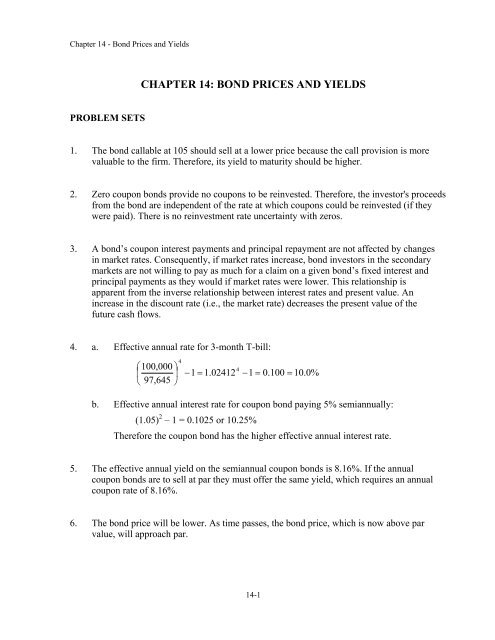
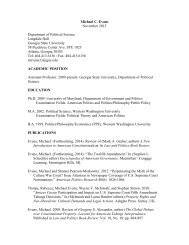
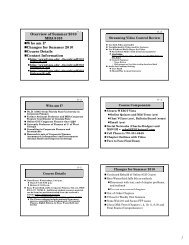
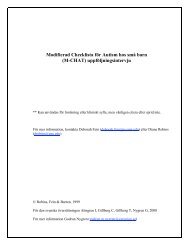
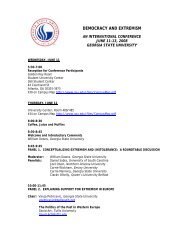
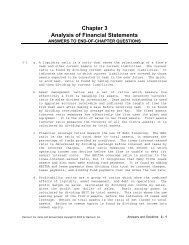
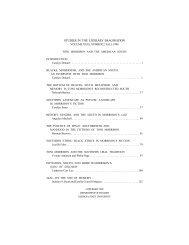
![HIST 4330--6920 Spring 2010 Kuhn[1] - Georgia State University](https://img.yumpu.com/15992617/1/190x245/hist-4330-6920-spring-2010-kuhn1-georgia-state-university.jpg?quality=85)

